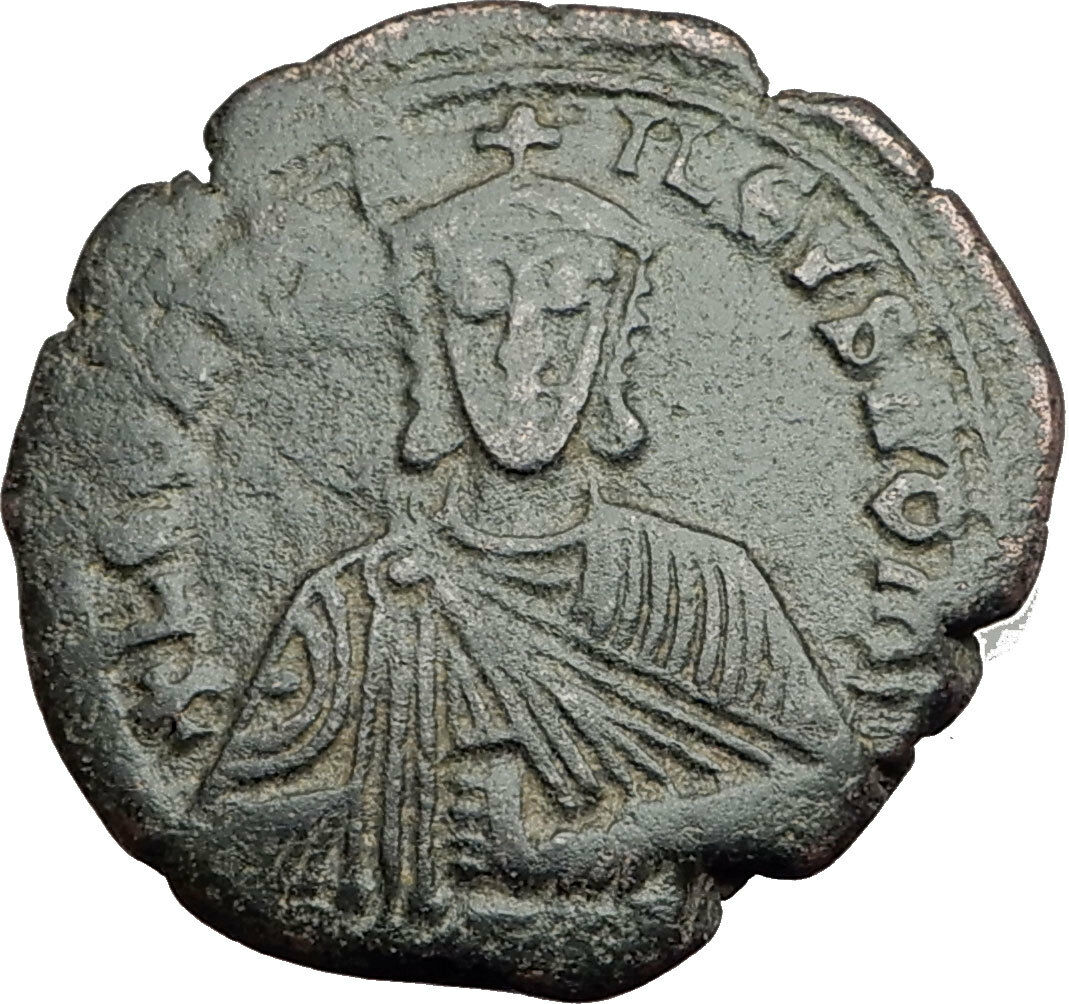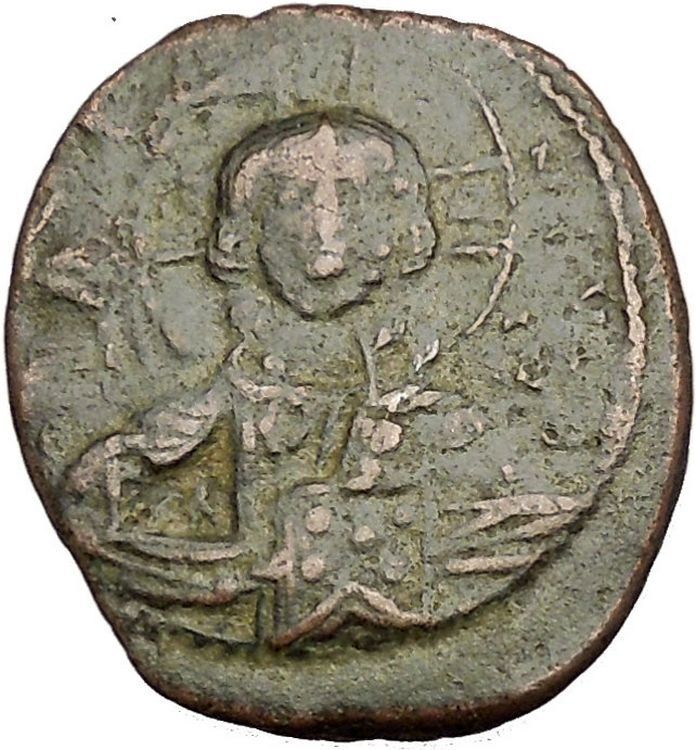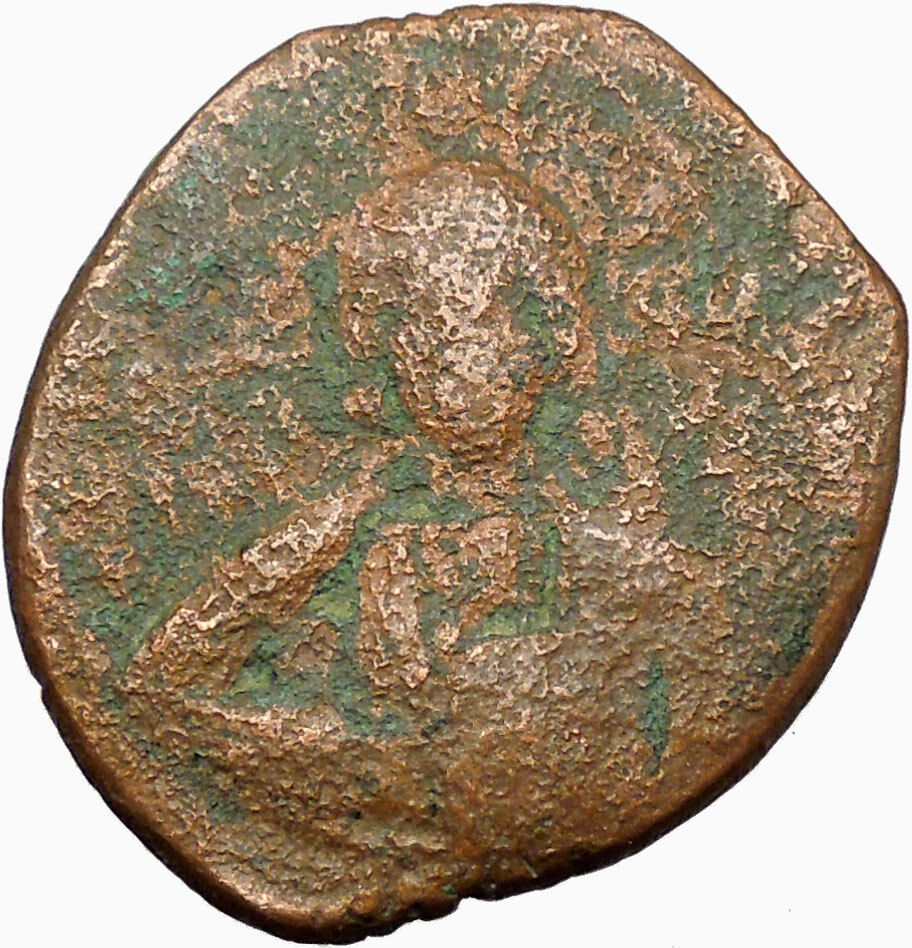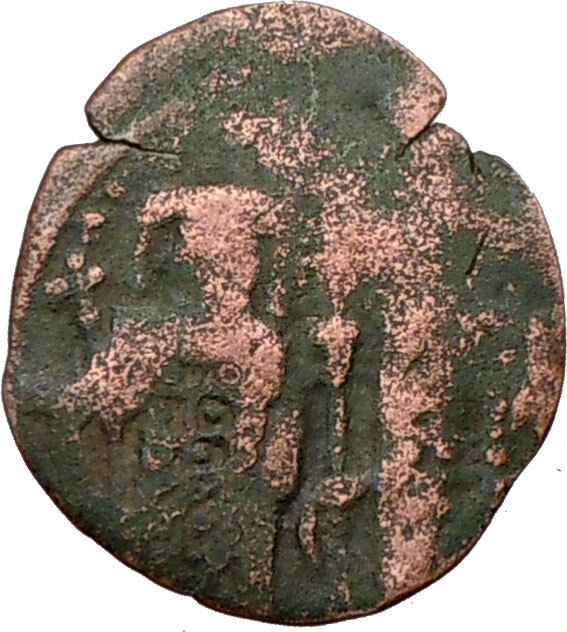|
Byzantine Empire – Anonymous Class A3
Bronze Follis 26mm (9.92 grams) struck circa 1020-1028 A.D.
Reference: Sear 1813
Certification: NGC Ancients Ch AU Strike: 4/5 Surface: 3/5 4681652-012
+ ЄMMANOVHΛ, Bust of Jesus Christ facing, wearing a nimbus crown, pallium and colobium, and holding book of Gospels with both hands; IC XC to left and right of bust.
+IhSЧS / XRISTЧS / bASILЄЧ / bASILЄ (“Jesus Christ King of Kings”) in four lines.
For more than a century, the production of Follis denomination Byzantine coins had religious Christian motifs which included included Jesus Christ, and even Virgin Mary. These coins were designed to honor Christ and recognize the subservient role of the Byzantine emperor, with many of the reverse inscriptions translating to “Jesus Christ King of Kings” and “May Jesus Christ Conquer”. The Follis denomination coins were the largest bronze denomination coins issued by the Byzantine empire, and their large size, along with the Christian motif make them a popular coin type for collectors. This series ran from the period of Byzantine emperors John I (969-976 A.D.) to Alexius I (1081-1118 A.D.). The accepted classification was originally devised by Miss Margaret Thompson with her study of these types of coins. World famous numismatic author, David R. Sear adopted this classification system for his book entitled, Byzantine Coins and Their Values. The references about this coin site Mr. Sear’s book by the number that they appear in that work. The class types of coins included Class A1, Class A2, Class A3, Class B, Class C, Class D, Class E, Class F, Class G, Class H, Class I, Class J, Class K.
-
Read the JESUS CHRIST Anonymous Class A-N Byzantine Follis Coins Reference and Guide
-
See ALL the Jesus Christ Anonymous Follis coins for sale.
-
See ALL coins bearing Jesus Christ or related available for sale.
You are bidding on the exact item pictured, provided with a Certificate of Authenticity and Lifetime Guarantee of Authenticity.
 Jesus (7-2 BC to AD 30-33), also referred to as Jesus of Nazareth or Jesus Christ, is the central figure of Christianity, whom the teachings of most Christian denominations hold to be the Son of God. Christians believe Jesus is the awaited Messiah (or Christ, the Anointed One) of the Old Testament. Jesus (7-2 BC to AD 30-33), also referred to as Jesus of Nazareth or Jesus Christ, is the central figure of Christianity, whom the teachings of most Christian denominations hold to be the Son of God. Christians believe Jesus is the awaited Messiah (or Christ, the Anointed One) of the Old Testament.
Virtually all modern scholars of antiquity agree that Jesus existed historically, and historians consider the Synoptic Gospels (Matthew, Mark and Luke) to be the best sources for investigating the historical Jesus. Most scholars agree that Jesus was a Galilean, Jewish rabbi who preached his message orally, was baptized by John the Baptist, and was crucified by the order of the Roman Prefect Pontius Pilate. In the current mainstream view, Jesus was an apocalyptic preacher and the founder of a renewal movement within Judaism, although some prominent scholars argue that he was not apocalyptic. After Jesus’ death, his followers believed he was resurrected, and the community they formed eventually became the Christian church. The widely used calendar era, abbreviated as “AD” from the Latin “Anno Domini” (“in the year of our Lord”) or sometimes as “CE”, is based on the birth of Jesus.
 Christians believe that Jesus has a “unique significance” in the world. Christian doctrines include the beliefs that Jesus was conceived by the Holy Spirit, was born of a virgin named Mary, performed miracles, founded the Church, died by crucifixion as a sacrifice to achieve atonement, rose from the dead, and ascended into Heaven, whence he will return. Most Christians believe Jesus enables humans to be reconciled to God, and will judge the dead either before or after their bodily resurrection, an event tied to the Second Coming of Jesus in Christian eschatology; though some believe Jesus’s role as savior has more existential or societal concerns than the afterlife, and a few notable theologians have suggested that Jesus will bring about a universal reconciliation. The great majority of Christians worship Jesus as the incarnation of God the Son, the second of three persons of a Divine Trinity. A few Christian groups reject Trinitarianism, wholly or partly, as non-scriptural. Christians believe that Jesus has a “unique significance” in the world. Christian doctrines include the beliefs that Jesus was conceived by the Holy Spirit, was born of a virgin named Mary, performed miracles, founded the Church, died by crucifixion as a sacrifice to achieve atonement, rose from the dead, and ascended into Heaven, whence he will return. Most Christians believe Jesus enables humans to be reconciled to God, and will judge the dead either before or after their bodily resurrection, an event tied to the Second Coming of Jesus in Christian eschatology; though some believe Jesus’s role as savior has more existential or societal concerns than the afterlife, and a few notable theologians have suggested that Jesus will bring about a universal reconciliation. The great majority of Christians worship Jesus as the incarnation of God the Son, the second of three persons of a Divine Trinity. A few Christian groups reject Trinitarianism, wholly or partly, as non-scriptural.
In Islam, Jesus (commonly transliterated as Isa) is considered one of God’s important prophets and the Messiah, second in importance only to Muhammad. To Muslims, Jesus was a bringer of scripture and was born of a virgin, but was not the Son of God. According to the Quran, Jesus was not crucified but was physically raised into Heaven by God. Judaism rejects the belief that Jesus was the awaited Messiah, arguing that he did not fulfill the Messianic prophecies in the Tanakh.

Basil II (Greek: Βασίλειος Β΄, Basileios II; 958 – 15 December 1025) was a Byzantine Emperor from the Macedonian dynasty who reigned from 10 January 976 to 15 December 1025. He was known in his time as Basil the Porphyrogenitus and Basil the Young to distinguish him from his supposed ancestor, Basil I the Macedonian.
The early years of his long reign were dominated by civil war against powerful generals from the Anatolian aristocracy. Following their submission, Basil oversaw the stabilization and expansion of the eastern frontier of the Byzantine Empire, and above all, the final and complete subjugation of Bulgaria, the Empire’s foremost European foe, after a prolonged struggle. For this he was nicknamed by later authors as “the Bulgar-slayer“, by which he is popularly known. At his death, the Empire stretched from Southern Italy to the Caucasus and from the Danube to the borders of Palestine, its greatest territorial extent since the Muslim conquests four centuries earlier.
Despite near-constant warfare, Basil also showed himself a capable administrator, reducing the power of the great land-owning families who dominated the Empire’s administration and military, while filling the Empire’s treasury. Of far-reaching importance was Basil’s decision to offer the hand of his sister Anna to Vladimir I of Kiev in exchange for military support, which led to the Christianization of the Kievan Rus’ and the incorporation of Russia within Byzantine cultural sphere.
Constantine VIII (Greek: Κωνσταντίνος Η΄, Kōnstantinos VIII) (960 – 11 November 1028) was reigning Byzantine Emperor from 15 December 1025 until his death. He was the son of the Emperor Romanos II and Theophano, and the younger brother of the eminent Basil II, who died childless and thus left the rule of the Byzantine Empire in his hands.
Family
As a youth, Constantine VIII had been engaged to a daughter of Emperor Boris II of Bulgaria, but in the end he married a Byzantine aristocrat named Helena, daughter of Alypius. By her he had three daughters: Eudokia, who became a nun, Zoe, future empress, and Theodora.
Life
Constantine VIII had been crowned with his brother by their father from 962; he was then only an infant. However, for some 63 out of the 68 years of his life he was eclipsed by other emperors, including Nikephoros II Phokas, John I Tzimiskes, and Basil II. Even when his elder brother became senior emperor, Constantine was perfectly content to enjoy all the privileges of Imperial status without concerning himself with state affairs. On occasion Constantine participated in his brother’s campaigns against rebel nobles. In 989, he acted as mediator between Basil II and Bardas Skleros. Otherwise he spent his life in the search of pleasure and entertainment, including spectator sports at the Hippodrome of Constantinople, or amusing himself with riding and hunting.
When Basil II died on 15 December 1025, Constantine finally became sole emperor, although he ruled for less than three years before his own death on 11 November 1028.
Physically Constantine was tall and graceful, where Basil had been short and stocky. He was a superb horseman. By the time he became emperor, he had chronic gout and could hardly walk. His reign was a disaster because he lacked courage and political savvy. He reacted to every challenge with impulsive cruelty, persecuting uppity nobles and allegedly ordering the execution or mutilation of hundreds of innocent men. Constantine carried on as he always had: hunting, feasting, and enjoying life – and avoided state business as much as possible. He was poor at appointing officials. Within months, the land laws of Basil II were dropped under pressure from the Anatolian aristocracy (the dynatoi), although Constantine struck at the nobility when threatened by conspiracy.
Like his brother, Constantine died without a male heir. The Empire thus passed to his daughter Zoe, whom he had married to Romanos Argyros. Their other daughter, Irene married Vsevolod I of Kiev and had descendants.

The Byzantine Empire at the death of Basil II in 1025
|









 Jesus (7-2 BC to AD 30-33), also referred to as Jesus of Nazareth or Jesus Christ, is the central figure of Christianity, whom the teachings of most Christian denominations hold to be the Son of God. Christians believe Jesus is the awaited Messiah (or Christ, the Anointed One) of the Old Testament.
Jesus (7-2 BC to AD 30-33), also referred to as Jesus of Nazareth or Jesus Christ, is the central figure of Christianity, whom the teachings of most Christian denominations hold to be the Son of God. Christians believe Jesus is the awaited Messiah (or Christ, the Anointed One) of the Old Testament. Christians believe that Jesus has a “unique significance” in the world. Christian doctrines include the beliefs that Jesus was conceived by the Holy Spirit, was born of a virgin named Mary, performed miracles, founded the Church, died by crucifixion as a sacrifice to achieve atonement, rose from the dead, and ascended into Heaven, whence he will return. Most Christians believe Jesus enables humans to be reconciled to God, and will judge the dead either before or after their bodily resurrection, an event tied to the Second Coming of Jesus in Christian eschatology; though some believe Jesus’s role as savior has more existential or societal concerns than the afterlife, and a few notable theologians have suggested that Jesus will bring about a universal reconciliation. The great majority of Christians worship Jesus as the incarnation of God the Son, the second of three persons of a Divine Trinity. A few Christian groups reject Trinitarianism, wholly or partly, as non-scriptural.
Christians believe that Jesus has a “unique significance” in the world. Christian doctrines include the beliefs that Jesus was conceived by the Holy Spirit, was born of a virgin named Mary, performed miracles, founded the Church, died by crucifixion as a sacrifice to achieve atonement, rose from the dead, and ascended into Heaven, whence he will return. Most Christians believe Jesus enables humans to be reconciled to God, and will judge the dead either before or after their bodily resurrection, an event tied to the Second Coming of Jesus in Christian eschatology; though some believe Jesus’s role as savior has more existential or societal concerns than the afterlife, and a few notable theologians have suggested that Jesus will bring about a universal reconciliation. The great majority of Christians worship Jesus as the incarnation of God the Son, the second of three persons of a Divine Trinity. A few Christian groups reject Trinitarianism, wholly or partly, as non-scriptural.






